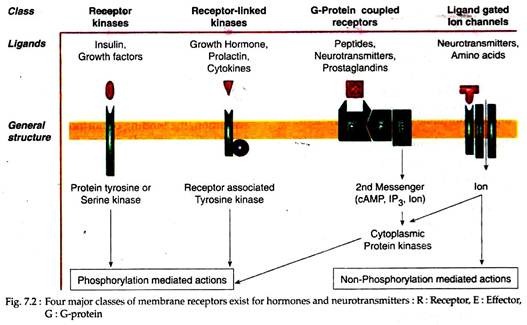Extracellular Membrane Receptors Are Used by Which Types of Hormones
They are able to produce secondary messengers. Examples are progesterone and testosterone as well as thyroid hormones.

Figure 15 15 Three Classes Of Cell Surface Receptors Molecular Biology Of The Cell Ncbi Bookshelf Molecular Biology Cell Biology Biology
Once an odorant is bound to a receptor that receptor is desensitized and does not respond to another odor for a period of time.

. Used EVs embedded with an antibody against IL-3 receptors whereupon delivery to the MDA-MB-231 TNBC cell line expressing IL-3 receptor directly reduced the cell viability and cell migration. The protein and peptide hormones usually function in such a way. Some hormones do not enter the target organ and they just interact with the membrane-bound receptors.
The plasma membrane folds inward invaginates forming a cavity that fills with extracellular fluid dissolved molecules food particles foreign matter pathogens or other substances. Each odorant can bind to multiple olfactory receptors. The plasma membrane folds back on itself until the ends of the in-folded membrane meet.
GPCRs the superfamily of human membrane receptors encoded by nearly 800 genes in the human genome medicate cell proliferation metabolism and neuromodulation. Three types of signaling. For example Lopatina et al.
Small lipophilic molecules that diffuse through the cell membrane to reach cytosolic or nuclear receptors. Each olfactory receptor can bind multiple types of odorants. Over 20 different types of enteroendocrine cell types have been identified to date each of which secretes one or more regulatory peptides or bioactive molecules Table 1.
This traps the fluid inside the vesicle. These hormones come in contact with the external domain that is present on the extracellular surface of the cell. In endocrine signaling hormones are produce by an endocrine gland and sent through the blood stream to distant cells.
Membrane-embedded molecules on EVs can be used directly or indirectly against a target cell. They span the entirety of the membrane with 7 transmembrane helices and translate the extracellular stimulus into physiological signals in the cell 2324. These hormones can act locally on enteroendocrine cells on immune cells nerve endings or organs at remote sites including pancreatic islets and the central nervous system.

Blogos Metabolism Viii The Cellular Membrane Tzeruf And The 231 Gates Membrane Cellular Anatomy And Physiology
Hormones Anatomy And Physiology Ii

Steroid Hormone Action Plasma Membrane Steroid Hormone Steroids

Plasma Membrane Hormone Receptors Biology For Majors Ii

Cyclic Amp Second Messenger Mechanism Of Water Soluble Hormones Proteins Receptors Are In The Plasma Membrane Biochemistry Anatomy And Physiology Physiology
E Hormone Endocrine System Types Of Hormones

Ligands Receptors G Proteins Article Khan Academy Biology Cell Biology Medical Studies

Nuclear Receptor Wikipedia Cell Membrane Extracellular Fluid Hormones
E Hormone Endocrine System Types Of Hormones

Cyclic Amp Second Messenger Mechanism Of Water Soluble Hormones Proteins Receptors Are In The Plasma Membrane Biochemistry Anatomy And Physiology Physiology
Hormones Anatomy And Physiology Ii
Mechanism Of Action Hormones With Cell Surface Receptors






Comments
Post a Comment